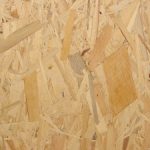There are five main types of man-made board available to the DIY-er. Each has different properties and not all are suitable for all tasks. All types of man-made board are generally cheaper and easier to work with that solid wood, and are available in a large range of sizes.
Chipboard
Chipboard, also known as Particle Board, is a man-made material consisting of small wood chips bonded into a sheet using resin. The size of the chips can vary, but generally chipboard has a reasonably smooth face with rough, crumbly edges. It is difficult to achieve a smooth edge when working with chipboard. Chipboard sheets are available in a variety of thicknesses, from 12mm up to 30mm or more. The most common thicknesses are 12mm and 18mm.
 Chipboard is heavy and dense, often making it difficult to work and hard on cutting tools. This is due to the high resin content. Chipboard is mainly used where it will not be seen or as the body of laminated products such as kitchen worktops and the cheaper type of flatpack furniture. It is also sometimes used as a flooring material in newer homes.
Chipboard is heavy and dense, often making it difficult to work and hard on cutting tools. This is due to the high resin content. Chipboard is mainly used where it will not be seen or as the body of laminated products such as kitchen worktops and the cheaper type of flatpack furniture. It is also sometimes used as a flooring material in newer homes.
Chipboard and hardboard were once the most commonly used type of man-made board. In recent years they have been replaced by the stronger, cleaner and easier to work MDF (Medium-Density Fibreboard).
Plywood
Plywood is made by bonding several thin layers of wood veneer (known as plies) under extreme pressure. The grain of each layer is laid in alternating directions to increase the strength of the finished sheet of plywood. Depending on the type of glue used in the bonding process, plywood can be used both inside and outside.
High quality plywood can be used for furniture making and, when different veneers are used for each layer, the exposed end of the plywood makes a nice feature. Standard plywood is mainly used for construction purposes such as shuttering concrete. Plywood is available in large sheets at a variety of thicknesses from 3mm to over 18mm.
Fibreboard
Made from highly compressed wood fibres in a range of densities, fibreboard is used in a wide variety of settings. Soft fibreboard is often used for insulation and wall sheathing, as well as for products such as pinboards. Medium Density Fibreboard (or MDF) is a popular material and is available in both small and large sheets, in thicknesses ranging from 3mm to 25mm or more. It is smooth on both sides and therefore suitable for use as a facing material as well as being used as the carcass of modern furniture products. You can even buy thin MDF with grooves cut in one side to allow it to be formed into a smooth curve.
Hardboard
Like fibreboard, hardboard is made of highly compressed softwood fibres. Generally thinner and less strong than other man-made boards, hardboard is both a cheap and stable product. Standard hardboard is around 3mm thick and brown in colour, with a rough side and a smooth side.
Generally used for the backs of flat-pack cabinets, small sliding doors and other products which need a relatively strong but lightweight board. It is also widely used fopr levelling wooden floors in preparation for applying other floor coverings (laminate flooring, etc). Available perforated, oil tempered, flame retardant and prefinished, among other finishes.
Blockboard
Blockboard is constructed of several rectangular strips of wood sandwiched between a double layer of pressure-bonded veneer. Blockboard is extremely strong and often used where structural strength is needed. As it is veneered, blockboard is also suitable for use as a facing material, but exposed edges will need to be covered in a process called Lipping (gluing thin strips of additional veneer along the exposed edge). Available in large sheets and in thicknesses from 12mm to 25mm.







